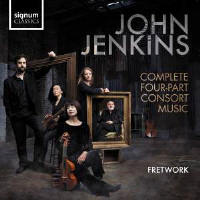Texte paru dans: / Appeared in: |
|
|
Outil de traduction ~ (Très approximatif) |
|
|
Reviewer: Jerry
Dubins In 35:5, Christopher Brodersen reviewed a recording on Musica Ficta of John Jenkins’s ostensibly complete fantasias of four parts for viol consort, performed by an ensemble calling itself The Spirt of Gambo. I’ve not heard that release, but I would like to echo Christopher’s feelings about the music because they closely parallel my own. “This highly refined, ethereal music,” he wrote, “may be an acquired taste for some. For me, it inhabits the same lofty plane as Bach’s Art of Fugue or Beethoven’s late string quartets.” It’s always comforting to learn that certain musical works resonate in the same deep way for others as they do for one’s own self. As it seems so for Brodersen, I, too, find myself transported by this music to a place of exalted communion and oneness with the cosmos.
One of music history’s
enduring mysteries is where the string quartet came from. From approximately
the middle of the 16th century through the third quarter of the 17th
century, there flourished in England an active school of lute and viol
players and composers who built up an incomparably rich body of works
centered on lute tablature, lute songs, and viol consort music (aka “chest
of viols”). In his review, Brodersen mentions six of them, but there were
many more. For sure, Jenkins’s Fantasias of Four Parts are not unprecedented in terms of number of voices, but they are not the rule. An examination of much of the viol consort literature reveals that the majority of works was written in five or six parts. The typical consort of viols of the period, according to Thomas Mace (1612/3–c. 1706), a lutenist, viol player, singer, composer, and early Baroque music theorist, was composed of six instruments: two basses, two tenors, and two trebles; or one bass, three tenors, and two trebles.
But we also know that by at least the middle of the 17th century, violins were being mixed into the consort or substituted for the treble viols. A recording by the highly regarded Parley of Instruments produced an album of Fantasia Suites, dating from around 1661 by this very John Jenkins in which violins and bass viols are cohabiting members of the consort. That Hyperion CD was reviewed by Tom Moore in 16:3. By the mid-1600s, the family of viol instruments was already marked for obsolescence, to be replaced by instruments of the violin family. The transition wouldn’t happen overnight, but a prototype of the modern string quartet—two violins, viola, and cello—can be traced back to a four-part sonata for string ensemble by Gregorio Allegri (c. 1582–1652), a Roman Catholic priest, and composer, who is credited with having produced the first string quartet.
Generally, the origins of the string quartet are dated to a later period and specifically to the Baroque trio sonata for two solo string instruments with continuo—i.e., a keyboard instrument with a reinforcing bass instrument. By the beginning of the 18th century, composers began adding a third solo string instrument, keeping the low bass string instrument, and dropping the keyboard instrument, and thus was born the modern string quartet. But there is some evidence to suggest that the embryonic stage of the string quartet actually dates back further, to these viol consort pieces by Jenkins and others perhaps 50 years earlier.
At the outset of this review, I wrote that the recording of Jenkins’s Fantasias of Four Parts by The Spirit of Gambo, reviewed by Brodersen, was “ostensibly” complete. That album contains 13 fantasias and one pavan. This new recording by Fretwork contains 17 fantasias and two pavans, so it would seem that The Spirit of Gambo’s collection wasn’t so complete after all. The one drawback, of course, is that the extra four fantasias and one extra pavan have caused Fretwork’s survey to spill over onto a second disc, though to be honest, I think the 83 minutes of this release could have been accommodated on a single disc. Some listeners may also feel that there’s enough sameness to the textures and emotional range of these pieces that the 14 of them offered by The Spirit of Gambo are sufficient. Even Christopher Brodersen, whose high esteem of this music I share, writes, “It’s best to listen to the music in small doses, otherwise it becomes difficult to follow Jenkins’s contrapuntal arguments after a while.”
There is yet another factor to consider, however, beyond the completeness of these two versions. Fanfare contributor Jonathan Woolf happened to review The Spirit of Gambo disc as a critic for MusicWeb International, and he reported that “The ensemble is five strong and flexible, and two of the players double, thus they play two treble viols, two tenor, and two bass, in varying combinations, with organ.” Brodersen states that “The Spirt of Gambo is a four-member viol consort,” and makes no mention of an organ. Again, I haven’t heard the Gambo album, so I can’t say who is right on this point, but I can tell you that the long-established and famed Fretwork ensemble, which has graced us with its exquisite playing of this transcendently beautiful music, plays it as written for treble viol, two tenor viols, and bass viol. The reason there are three tenor viol players—Reiko Ichise, Sam Stadlen, and Emily Ashton—is that Ichise plays tenor viol throughout, while Stadlen plays tenor viol in the Fantasias 1 through 9 and the Pavan in D Minor, and Ashton plays tenor viol in the Fantasias 10 through 17 and the Pavan in E Minor. Thus, at no time are there more than four voices playing, and there is no organ, which, I’m no expert, but I don’t think had a place in viol consort works. For an out-of-body experience of the good kind, urgently recommended. | |
|
|
|
|
|
|
|
Cliquez l'un ou l'autre
bouton pour découvrir bien d'autres critiques de CD |
|




